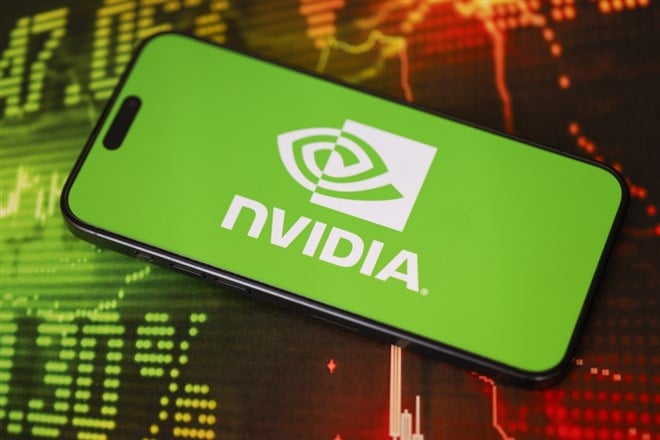Ticker Reports for May 22nd
These Are the Only 6 Stock Stocks in NVIDIA's 13F Portfolio
Many investors closely watch 13F filings from institutional money managers. While chip giant NVIDIA (NASDAQ: NVDA) isn’t typically seen in that role, it must file as well, since it manages over $100 million in U.S.-traded securities.
Below is a breakdown of the six stocks listed on NVIDIA’s most recent 13F.
Examining these holdings provides insight into the types of technology that this pioneering company is betting on.
All return data calculates the change in price through the May 21 close, since NVIDIA revealed its initial stake in these companies, including their initial rise.
NVIDIA’s Top 3 Chip and AI Infrastructure Investments Don’t Fall Far From the Tree
By far, NVIDIA’s largest 13F holding was CoreWeave (NASDAQ: CRWV).
CoreWeave accounted for 78% of NVIDIA’s total reported 13F holdings in Q1.
Aside from owning approximately 7% of CoreWeave, the company is also one of NVIDIA’s biggest customers.
CoreWeave uses its close relationship with NVIDIA to rent out the company’s most advanced AI chips to customers before anyone else.
On its last earnings call, CoreWeave said it was the first to deploy NVIDIA’s GB200 Grace Blackwell systems at scale.
Since going public in March, CoreWeave has increased by a staggering 169%, driven largely by the excitement surrounding its NVIDIA relationship.
The next two largest NVIDIA 13F holdings are Arm (NASDAQ: ARM) and Applied Digital (NASDAQ: APLD).
They represent around 10% and 4% of NVIDIA’s total $1.15 billion 13F portfolio.
NVIDIA actually tried to fully acquire ARM in 2020 for $40 billion; however, the transaction fell through due to regulatory issues.
ARM provides “IP cores," essentially the basic designs of chips that companies base their advanced chips on.
As such, ARM is a very important but somewhat underappreciated player in semiconductors.
Applied Digital is somewhat similar to CoreWeave, renting out computing power to customers.
However, it still gets a good amount of its revenue from cryptocurrency miners, something that CoreWeave no longer dabbles in.
The company is also tiny, comparatively, worth only around $1.5 billion.
Since November 2024, when NVIDIA first reported owning Applied Digital, the stock is down approximately 1%.
AI-Drug Research, Computing, & Autonomous Driving Round Out NVIDIA’s 13F Portfolio
NVIDIA’s fourth largest 13F holding is the clinical-stage drug company, Recursion Pharmaceuticals (NASDAQ: RXRX).
The company has no medicines approved by regulators yet, and thus doesn’t generate much revenue.
Overall, the company’s free cash flow over the last 12 months was around -$400 million.
The company is attempting to use AI to accelerate drug discovery and development.
Importantly, Recursion is an NVIDIA customer that uses the firm’s chips to power its supercomputer to achieve its mission.
It is prioritizing work on four cancer treatments and two rare disease treatments.
Even after jumping 24% the day NVIDIA revealed its initial investment in February 2024, shares are down 51%.
NVIDIA’s final two holdings are Nebius Group (NASDAQ: NBIS) and WeRide (NASDAQ: WRD), each making up around 2% of its portfolio.
Nebius’s business model is also very similar to CoreWeave’s, which is renting out AI computing power.
Like CoreWeave, it is also seeing incredible revenue growth, reporting a 385% increase in sales in Q1.
Nebius will be among the first companies that will offer NVIDIA’s new Blackwell Ultra AI factory platform.
Despite rising 7% on the day the initial NVIDIA investment came out, investors have seen shares drop nearly 7% overall.
Last up is WeRide. The company operates a variety of robotaxis and other autonomous driving vehicle platforms, primarily in China.
WeRide uses NVIDIA’s advanced chips to operate its technology.
Even including the 83% surge in shares after NVIDIA revealed its initial investment in February, they have fallen nearly 40% overall since then as of May 21.
NVIDIA’s 13F Holdings: Prudent Examination Still Reigns Supreme
There is one clear common thread among all these companies in which NVIDIA is investing: they are either customers or suppliers of NVIDIA. This makes sense considering that NVIDIA would deeply understand their businesses.
Overall, having investments from NVIDIA doesn't mean investors should blindly follow behind the tech giant and invest in these stocks.
This is especially true as merely associating with NVIDIA can often drive wild up moves in these names, only to see their shares crater back to earth.
Still, NVIDIA's investment is a positive, and directing a watchful eye toward these names makes sense.
Before it hits the headlines: the altcoin that's building quietly
While everyone's distracted by Bitcoin's moves, a stealth revolution is underway.
One altcoin is quietly positioning itself to overthrow the entire banking system.
Buy the Dip? 3 Oil Stocks Poised for a Big Comeback
The headlines from President Trump’s Middle East trip trumpeted the deals made by many of the leading technology companies. However, investors should note that the U.S. delegation included three oil services companies' chief executive officers (CEOs). Their stocks have been beaten down this year.
The bearish sentiment has increased this earnings season, driven by pessimistic outlooks based on tariff uncertainty, geopolitical uncertainty, and market volatility.
However, the biggest obstacle is the price of oil. Crude oil prices in the low $60 range disincentivize oil companies to drill, which hurts oil service companies. The recent news that OPEC+ nations will increase output also weighs on crude prices.
That leaves investors with a binary choice. Do they avoid energy stocks and look for growth in other sectors? That's certainly an option. However, contrarian investors may believe that crude oil prices will likely rise as the United States begins transforming to onshore manufacturing capacity in key industries.
However, oil prices don’t need demand growth to rise. An equally valid catalyst could be if oil falls to around $55. That would likely lead major oil companies to curtail production even in areas like the Permian basin, eventually raising the price of oil.
That would mean it’s a good time to look at three oil services companies that act as the picks and shovels for the oil and gas markets.
If the price of oil takes off, these names will be among the first to move higher.
Bullish Analyst Sentiment Is a Key Reason to Buy Baker Hughes
Baker Hughes Co. (NASDAQ: BKR) stock is down 8.7% in 2025. However, that’s coming off its strong performance in 2023 and 2024, which capped off a five-year run in which BKR stock has delivered a total return of over 200% for investors.
In its most recent quarter, the company delivered record adjusted EBITDA and, despite macroeconomic uncertainty, maintained its full-year guidance with the expectation that it would continue improving its margins through operational efficiency. The company’s forecasts presume that the price of oil will stay at current levels.
That’s likely a prudent move, but analysts believe oil will move higher. The consensus Moderate Buy rating among analysts comes with a price target of $49.11, which would be a gain of 31.5%.
Some analysts have lowered their price targets after the company’s cautious earnings report. However, even a smaller ceiling on the stock comes with a dividend that the company is committed to growing and currently yields 2.46%.
New Contracts Expand Halliburton’s International Presence
The case for Halliburton Co. (NYSE: HAL) looks similar to Baker Hughes. The company delivered a solid earnings report, institutions continue to buy the stock, and Halliburton uses operational efficiencies to solidify the fundamentals. On the downside, analysts have lowered their price targets since the company reported earnings.
However, the case for Halliburton may not depend as much on the outlook for the United States. In its most recent quarter, the company generated about 51% of its revenue from international operations. The company also announced three significant new contracts with Shell plc (NYSE: SHEL) that will add to its growth in the coming quarters.
Another reason investors may want to buy into the weakness in HAL stock is the company’s price-to-earnings (P/E) ratio. Its current and forward P/E ratios are below the sector average and are also a significant discount to its historical levels. Add in a safe 3.32% dividend yield, and investors have valid reasons for riding out the cycle in crude oil prices with a proven winner in the space.
The Size and Scale of SLB May Be Too Compelling to Ignore
With a market cap of over $46 billion as of this writing, SLB (NYSE: SLB), formerly known as Schlumberger, is one of the largest companies in this sector. That hasn’t spared it from the sector's overall weakness. SLB stock is down 9%. But in fairness, the stock managed to gain a small amount before the April tariff announcements sent the whole sector lower.
Looking at the company’s P/E ratio, SLB looks fairly valued compared to the sector average, but at a discount to its historical averages.
That’s likely due to the outlook for revenue and earnings. Both are expected to be negative single-digit levels in the next 12 months, far below their historical average.
That's also why analysts are lowering their price targets for SLB stock. However, the consensus price of $52.44 is more than 50% above its closing price on May 20, 2025. That gives it the highest potential upside among the three stocks on this list. Add in the 3.3 % dividend yield, and investors have good reason to buy the cyclical weakness of this sector leader.
Market Panic: Trump Just Dropped a Bomb on Your Stocks
tock Market Panic: Trump Just Dropped a Bomb on Your Stocks
The market is in freefall—and Trump's new tariffs just lit the fuse.
Millions of investors are blindsided as stocks plunge… but this is only Phase 1.
If you're still holding the wrong assets, you could lose 30% or more in the coming weeks.
Renaissance Hedge Fund's Biggest Q1 Buys Revealed
Even after fees, the fund's 39% return over this period was more than three times higher than the S&P 500's return. The fund also achieved a return of 76% in 2020, when the S&P 500 returned a bit more than 16%.
The details of the company’s 13F are intriguing, as the company prioritized spending on some of the biggest stocks in the world. Below are the details of Renaissance's biggest purchases in Q1 2025.
Looking at these companies' trading prices in Q1 can provide insight into the valuation levels where Renaissance may consider these stocks undervalued. This can help inform the decisions of retail investors when evaluating whether these stocks are overvalued or undervalued.
All relative return and price change data use closing prices as of May 20.
Renaissance Ups GOOGL Stake by Over Half a Billion Dollars
Coming in third place for Renaissance’s biggest buys in Q1 2025 is Google's parent company, Alphabet (NASDAQ: GOOGL). Renaissance bought nearly 2.3 million shares of Alphabet’s Class A shares and over 1.3 million Class C shares.
Overall, the reported value of the company’s investment in Alphabet increased from less than $600,000 to around $558 million. Notably, Alphabet’s Class A shares are trading nearly 10% below their average closing price of around $183 in Q1. Additionally, they are trading less than 6% above the low they reached in Q1.
This moderate amount of upside capture suggests that Renaissance still believes Alphabet is trading at a solid value.
Did DeepSeek Developments Change Renaissance’s Tune on Meta Platforms?
Renaissance’s second-biggest buy in Q1 was the Magnificent Seven stock, Meta Platforms (NASDAQ: META). The firm upped its stake in Meta considerably by nearly 550,000 shares.
This increased the value of the company’s position in Meta by over $300 million to $345 million. An interesting detail about Meta is that the stock’s lowest price this quarter was only about 1.5% lower than its price at the start of the quarter.
So, why did Renaissance buy so much Meta stock in Q1 despite its value barely dropping overall? Perhaps Renaissance’s perspective on Meta’s business changed positively in Q1.
Could they agree with Mark Zuckerberg’s take that DeepSeek is a positive for Meta, validating the company’s open-source approach to AI models? Overall, Meta is up just 11% from its lowest price in Q1 and is trading slightly below its average closing price in Q1 of $643.
This suggests that Renaissance likely still sees upside in this name, given that the company would not have been able to capture much upside so far.
Broadcom Was Renaissance’s Biggest Buy, But Is the Recovery Overdone?
Last up is Broadcom (NASDAQ: AVGO), the stock Renaissance spent the most on in Q1. The company added over 2.4 million shares to its Broadcom position in Q1. This was a massive change, as the company held only around 2,500 shares at the end of Q4 2024.
At the end of Q1, this position was worth approximately $406 million. This is by far the most significant number of Broadcom shares that Renaissance reported having been on a 13F since at least 2019.
Like many tech stocks, Broadcom's shares tumbled in Q1. DeepSeek news had shares down over 17% in one day in January. The stock’s lowest price in Q1 was just over $167. Since that quarterly low, shares are up over 38% as of the May 20 close.
Given this significant rise, it is certainly possible that the market has already squeezed out the juice Renaissance saw in this stock. However, no one knows at what price Renaissance purchased the shares.
Broadcom’s average closing price of around $211 in Q1 paints a potentially more favorable picture. Shares are up only around 10% from that level.
Looking into Renaissance’s most significant buys in Q1 provides a fascinating look at where the company saw value in the market. Understanding the trading ranges of these stocks in the quarter helps hone in on what Renaissance thinks these all-important stocks are worth.





